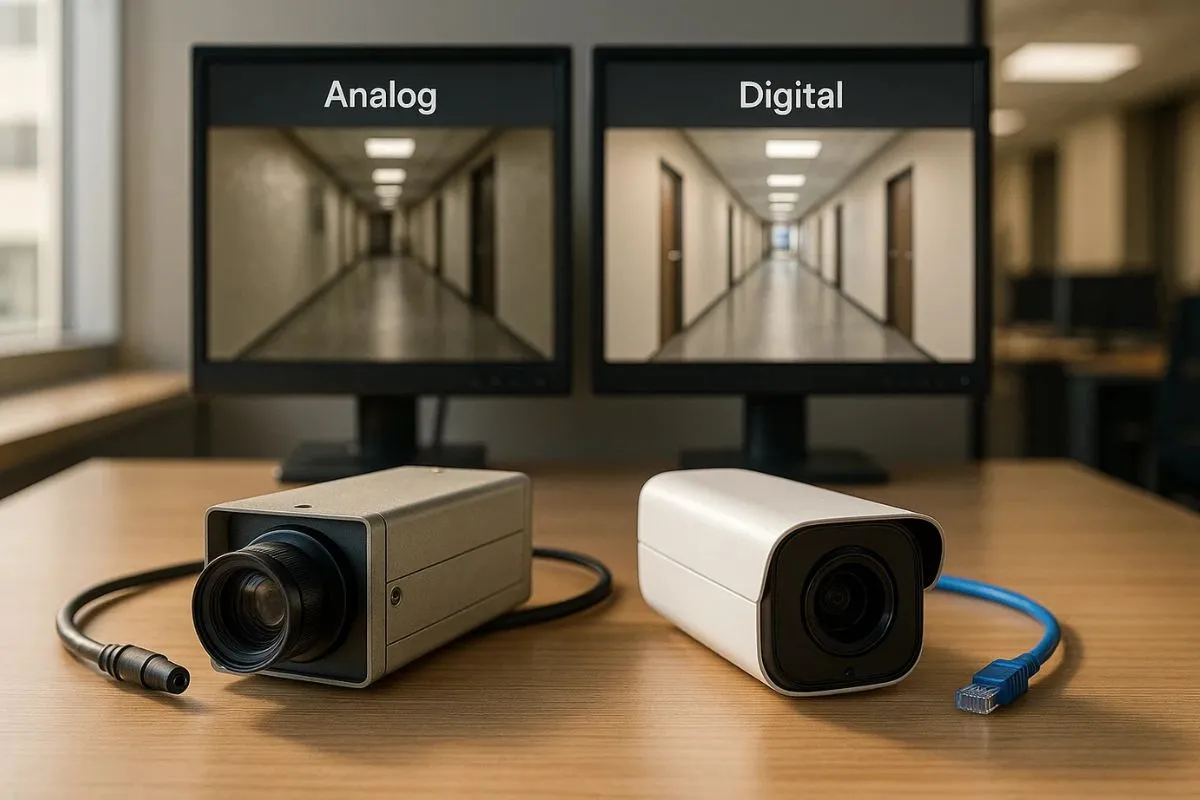We use cookies to personalise site content, social media features and to analyse our traffic. We also share information about your use of this site with our advertising and social media partners.
About Me
 Supreme Protection
Supreme Protection SSP Australia has over 15 years of experience delivering professional security services across Melbourne. Trust us for reliable protection, tailored security solutions, and highly trained, licensed security guards.
Posted by - Supreme Protection -
on - Oct 2 -
Filed in - Other -
-
75 Views - 0 Comments - 0 Likes - 0 Reviews

CCTV cameras are a cornerstone of modern security. They protect homes, offices, and businesses by recording activities and deterring intruders. Yet, many people are unsure about the difference between analog and digital CCTV cameras. Both are effective, but their functions, costs, and features vary. This guide breaks down the essentials so you can decide which system best fits your requirements.
Analog CCTV cameras are traditional surveillance devices that send video signals through coaxial cables to a DVR (Digital Video Recorder). The DVR converts these signals into digital format for storage. Analog systems are cost-effective and simple to install, making them popular in small shops and residential areas. However, the biggest drawback is video clarity—footage is often grainy and may not capture fine details like license plates or facial features.
Digital CCTV cameras, also known as IP cameras, use internet protocol to transmit footage. Instead of sending analog signals, they capture and deliver high-definition digital video directly to a Network Video Recorder (NVR) or cloud storage. The advantages include remote access, scalability, and sharp image quality. Businesses or homeowners who want modern, high-performing systems often prefer digital cameras.
The most obvious difference is resolution. Analog systems usually provide lower-quality images suitable for general monitoring. In contrast, digital cameras offer HD and even 4K resolution, ensuring clear and detailed footage. For situations requiring precise identification, such as retail security or high-risk environments, digital cameras outperform analog every time.
Analog cameras are relatively straightforward to set up, relying on coaxial cables for each camera. However, in larger setups, cabling becomes complicated. Digital systems simplify installation with Power over Ethernet (PoE), allowing one cable to supply both power and data. For hassle-free setups, professional services like CCTV Camera Installation can handle both analog and digital systems efficiently.
Analog cameras store data on DVRs with limited capacity, and upgrading storage usually requires additional equipment. Digital systems, however, can save video on NVRs, external servers, or cloud storage. Cloud-based options also provide secure backups and remote access, giving users peace of mind even if physical devices fail.
Analog systems typically lack built-in remote viewing. If you want to watch your property from afar, you’ll need additional hardware. Digital CCTV cameras, on the other hand, are designed with remote monitoring in mind. Using apps or web portals, you can view live streams from anywhere in the world—ideal for frequent travelers and businesses managing multiple sites.
Analog CCTV systems are generally cheaper upfront, making them attractive for smaller projects or tight budgets. However, they come with limitations like lower image quality and fewer features. Digital systems cost more initially but deliver long-term value through high resolution, flexible storage, and remote access. For businesses or larger properties, the investment in digital systems often pays off quickly.
Analog systems are less dependent on internet connectivity, which makes them reliable in areas with unstable networks. They continue recording to DVRs without interruption. Digital systems, however, rely on stable internet for remote features and cloud storage. Despite this, their superior video quality, scalability, and smart integration make them the go-to choice for advanced security needs.
Beyond image clarity, digital cameras include smart functions like motion detection, facial recognition, and integration with alarm systems. For example, many businesses pair IP cameras with Bosch security alarm packages to create a complete, layered security solution. These advanced features transform CCTV from a passive monitoring system into an intelligent security tool.
Analog CCTV is a solid choice for small shops, warehouses, and homeowners who want affordable, straightforward surveillance. If your priority is keeping costs down while maintaining basic monitoring, analog remains a dependable option.
Digital CCTV is ideal for high-security environments, large premises, or anyone who values remote access and crystal-clear images. It’s also the right choice if you plan to scale your system in the future. Businesses and homeowners seeking modern smart security systems often choose digital for its versatility.
For those upgrading from analog but not ready for a full digital switch, hybrid DVRs provide a balance. These allow integration of both analog and digital cameras, offering flexibility and cost savings during the transition.
Both analog and digital CCTV cameras have their place. Analog is budget-friendly and reliable for basic needs, while digital offers sharper images, smart features, and long-term scalability. The choice depends on your priorities—cost, image quality, or advanced security. Understanding the differences will help you invest in a system that provides lasting peace of mind.
1. Which CCTV camera gives clearer footage?
Digital CCTV cameras provide HD and 4K resolution, offering much clearer images than analog systems.
2. Can I upgrade my analog system to digital?
Yes, hybrid systems allow you to combine old analog cameras with new digital ones.
3. Do analog cameras need the internet?
No, they record directly to DVRs without internet access.
4. Are digital cameras harder to install?
They require networking knowledge, but professionals simplify the process.
5. Can I monitor my CCTV remotely?
Yes, digital systems support remote access via apps and web platforms.
6. Which is more cost-effective in the long run?
Digital systems have higher upfront costs but offer better features and scalability, making them more cost-effective over time.

“To assist disaster survivors by providing a source for them to come together in time of need, to aid in the listing of events, information and other forms of assistance, and continuing support through the recovery process.”
Share this page with your family and friends.